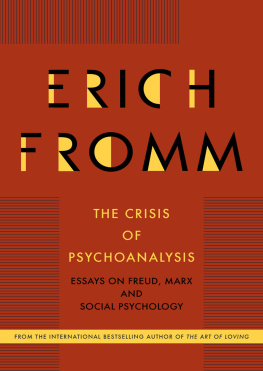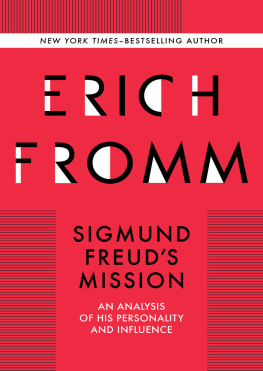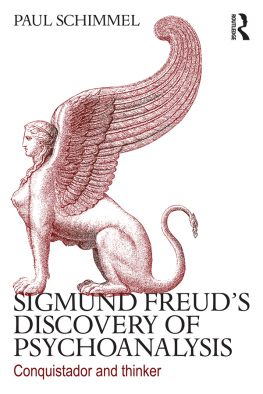B O L L I N G E N S E R I E S X X

THE COLLECTED WORKS
OF
C. G. JUNG
VOLUME 4
EDITORS
SIR HERBERT READ
MICHAEL FORDHAM, M.D., M.R.C.P.
GERHARD ADLER, PH.D.
WILLIAM MCGUIRE, executive editor
FREUD AND
PSYCHOANALYSIS
C. G. JUNG

TRANSLATED BY R. F. C. HULL
B O L L I N G E N S E R I E S X X


COPYRIGHT 1961 BY BOLLINGEN FOUNDATION, NEW YORK, N. Y PUBLISHED BY PRINCETON UNIVERSITY PRESS, PRINCETON, N. J.
Second printing, with corrections, 1970
Fourth printing, 1979
First Princeton / Bollingen Paperback printing, 1985
THIS EDITION IS BEING PUBLISHED IN THE UNITED STATES OF AMERICA BY PRINCETON UNIVERSITY PRESS AND IN ENGLAND BY ROUTLEDGE AND KEGAN PAUL, LTD. IN THE AMERICAN EDITION ALL THE VOLUMES COMPRISING THE COLLECTED WORKS CONSTITUTE NUMBER XX IN BOLLINGEN SERIES, SPONSORED BY BOLLINGEN FOUNDATION. THE PRESENT VOLUME IS NUMBER 4 OF THE COLLECTED WORKS, AND WAS THE ELEVENTH TO APPEAR.
ISBN 0-691-09765-8
ISBN 0-691-01864-2 (PBK.)
LIBRARY OF CONGRESS CATALOG CARD NUMBER: 75-156
MANUFACTURED IN THE UNITED STATES OF AMERICA
EDITORIAL NOTE
In the Editorial Note to Volume 1 it was pointed out that Jungs interest had gradually transferred itself, over the years, from psychiatry through psychoanalysis and typology to the theory of archetypes, and finally to the psychology of religious motifs. This facilitated the grouping of his published researches under the relevant headings, even though some of the material could equally well fit into any of several volumes. It follows that there is an underlying network linking, in time or subject-matter, each volume with others, and that wide reading among the volumes is required for a thorough grasp of Jungs views on any particular topic. From no single volume, whatever the arrangement, could the continuity of development be seen in historical perspective.
The present volume gives the substance of Jungs published writings on Freud and psychoanalysis between the years 1906 and 1916; two later papers are, however, added for reasons which will become apparent. Anyone familiar with Jungs work will be aware that references to Freuds observations and theories occur frequently throughout his writings; indeed, the discussion of them has engaged his interest from the beginning of the century to the present day. The scientific papers in this volume, while falling short of a complete account of Freud and psychoanalysis, nevertheless give the essential elements in Jungs changing views on this subject.
Between the years 1907 and 1912, when Jung was a psychoanalyst, his association with Freud was very close. Though the personal relationship between the two then became strained, largely owing to the publication of Wandlungen und Symbole der Libido in 191112, Jung continued to serve as president of the International Psycho-Analytical Association until 1914. ). The essay Freud and Jung: Contrasts was commissioned in 1929 by the editor of the Klnische Zeitung in view of the then current interest in the relation between Freud and Jung. It is included here because it shows the continuity in Jungs thinking from the time he wrote The Theory of Psychoanalysis (1912), serving at the same time as an outline of the changes that had taken place in the interim. In particular, it stresses that the element of confession and the personality of the investigator cannot be eradicated from psychological formulations and may even be considered an essential part of them. Jungs estimate of Freud must be seen in this light, not only in the writings in the present volume but in Volume 15, where Freud is viewed in his cultural setting. Freud and Jung: Contrasts and the Introduction to Kranefeldts Secret Ways of the Mind (1930) therefore form a basis for further study of Jungs reassessment of psychoanalysis in that and other volumes of this edition.
The concept of personality is closely bound up with the subject of typology, first broached in this volume and elaborated systematically in Psychological Types (Volume 6). Indeed, Jung has once again declared (in his British television broadcast, November 1959) that it was the difference between Freuds views and his own that originally impelled him to work out a psychology of types. We can see this very clearly in the publications between the years 1913 and 1921, when Psychological Types was published. The break with Freud was followed by a relatively fallow period. Except for a handful of publications chiefly in English only two works appeared during those years, but they .
The combination of scientific with less technical essays illustrates another aspect of editorial policy in this and other volumes. Over the years Jung has responded again and again to the widespread interest which psychoanalysis, and later analytical psychology, aroused. The Editors, therefore, have not hesitated to assemble in the same volume scientific articles with essays of a more popular nature.
TABLE OF CONTENTS
Translated from Die Hysterielehre Freuds: Eine Erwiderung auf die Aschaffenburgsche Kritik, Mnchener medizinische Wochenschrift (Munich), LIII (1906).
Translated from Die Freudsche Hysterietheorie, Monatsschrift fr Psychiatrie und Neurologie (Berlin), XXIII (1908).
Translated from LAnalyse des rves, Anne psychologique (Paris), XV (1909).
Translated from Ein Beitrag zur Psychologie des Gerchtes, Zentralblatt fr Psychoanalyse (Wiesbaden), I (1910/11).
Translated from Ein Beitrag zur Kenntnis des Zahlentraumes, Zentralblatt fr Psychoanalyse (Wiesbaden), I (1910/11).
Translated from a review in the Jahrbuch fr psychoanalytische und psychopathologische Forschungen (Leipzig), III (1911).
Translated from Zur Kritik ber Psychoanalyse, Jahrbuch fr psychoanalytische und psychopathologische Forschungen (Leipzig), II (1910).
Translated from Zur Psychoanalyse, Wissen und Leben (Zurich), V (1912).
Translated from Versuch einer Darstellung der psychoanalytischen Theorie, 2nd edn. (Zurich: Rascher, 1955).
Translated from Allgemeine Aspekte der Psychoanalyse, the original ms., which was published (in an anonymous translation) in Transactions of the Psycho-Medical Society (Cockermouth, England), 1913.
Originally published in English as On Psychoanalysis in Collected Papers on Analytical Psychology (London: Baillire, Tindall and Cox, 1916).
Translated from Psychotherapeutische Zeitfragen: Ein Briefwechsel mit Dr. C. G. Jung, edited by Dr. R. Lo (Leipzig and Vienna: Deuticke, 1914).
Originally published in the book, edited by Constance E. Long (London: Baillire, Tindall and Cox, 1916; 2nd edn., 1917).
Translated from Die Bedeutung des Vaters fr das Schicksal des Einzelnen (3rd revised edn., Zurich: Rascher, 1949), including material from the 1st edn. (1909).
Next page









